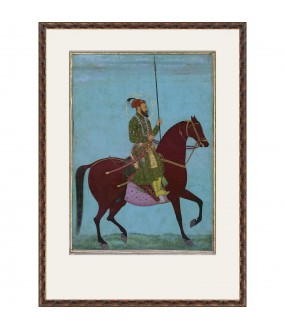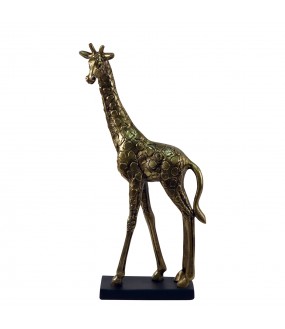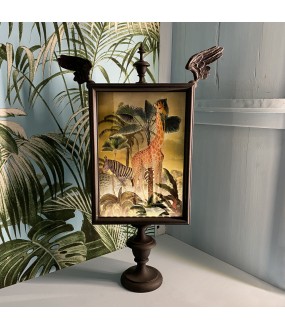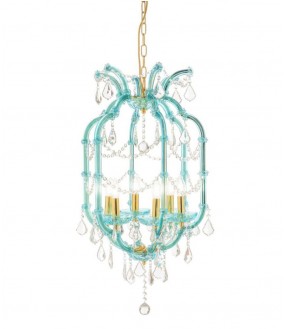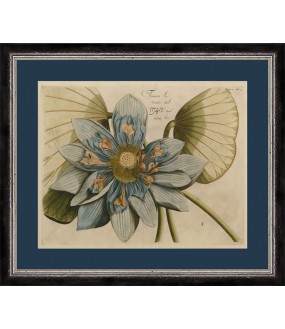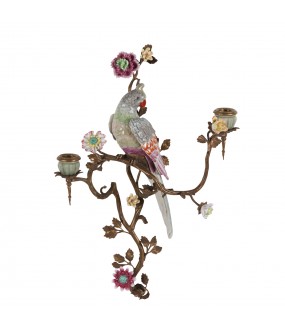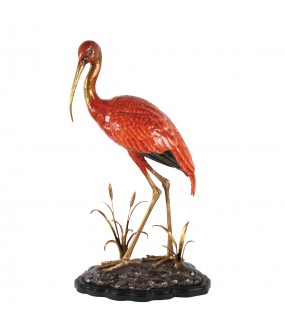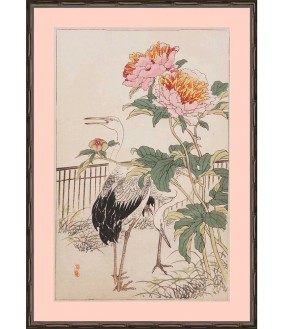Bon Voyage !

-
Brass and Porcelain Monkeys Bookends, H35cm
€1,530.00Large porcelain bookends 35cm high. Figurines of bronze monkeys with palm trees.
An unusual decorative object, two malicious bronze monkeys under their palm.
Bookends made of black porcelain and bronze palm trees -
Engraving of Aurangzeb 50x70cm
€360.00Magnificent engraving of Aurangzeb parading on horseback.
Beautiful warm and deep colors, aged carved wood frame.
Dimensions of the glass pane: 50x70cm.
Muhi al-Din Muhammad (c. 1618 – March 3, 1707), commonly known as Aurangzeb lit. 'Ornament of the throne' and by his royal name Alamgir I, lit. 'Conqueror of the world', was the sixth Mughal emperor, reigning from 1658 until his death in 1707.
Under his reign, the Mongol empire reached its peak with a territory covering almost the entire Indian subcontinent.
Widely considered the last effective Mongol ruler, Aurangzeb compiled the Fatawa 'Alamgiri and was among the few monarchs to fully establish Sharia law and Islamic economics throughout the Indian subcontinent.
Aurangzeb belonged to the aristocratic Timurid dynasty, held administrative and military positions under his father Shah Jahan (r. 1628–1658), and was recognized as an accomplished military commander. Aurangzeb was viceroy of Deccan in 1636-1637 and governor of Gujarat in 1645-1647. He jointly administered the provinces of Multan and Sindh in 1648-1652 and continued his expeditions into neighboring Safavid territories. In September 1657, Shah Jahan appointed his eldest and liberal son Dara Shikoh as his successor, a decision repudiated by Aurangzeb, who proclaimed himself emperor in February 1658. In April 1658, Aurangzeb defeated Shikoh's allied army and the kingdom of Marwar at victory. Aurangzeb's decisive victory at the Battle of Samugarh in May 1658 cemented his sovereignty and his suzerainty was recognized throughout the Empire. After Shah Jahan recovered from his illness in July 1658, Aurangzeb declared him incompetent to rule and imprisoned his father in Agra Fort.
-
Giraffe Figurine H45cm or H35cm
€180.00Giraffe in solid gilded and aged metal.
Large model: total height of 45cm.
Small model: total height of 35cm.
An original piece.
-
Antique Parrots Engravings, Set of 2
€864.00A set of two beautiful reproductions of engravings of magnificent flamboyantly colored parrots whose species have unfortunately disappeared.
Engravings with powder pink marie-louis and very beautiful black wood ornamentation frame.
Glass size: 50x70cm
-
copy of Night Light Interioro , Italy, h61cm
€750.00Night light lamp representing a Giraffe and friends in the Jungle, 64cm high by 40cm wide.
A wonderful handcrafted decorative lamp, Italy.
A magnificent artisanal work of remarkable finesse.
Giraffe and his friends explore their new home in one of our light boxes full of poetry.
Entirely made by hand in the workshop, these creations can bring comfort to young and old alike on a dark night in the dark!
In each lamp, an atmosphere or landscape is created by a juxtaposition of exquisite hand engravings that are engraved and printed on antique presses from the 1800s. Each image is printed in black and white, cut out and then colored by hand in gouache and watercolor.
The handmade and sculpted frame is made of black patinated tulipwood. The frame is decorated on top with baroque style angel wings, Renaissance period (which can possibly be removed).
A marvel of refinement, pure escape.
This entirely handcrafted lamp which is made exclusively to order.
-
Turquoise Glass Chandelier
€1,490.00A crazy charm for this beautiful chandelier in natural and turquoise glass decorated with magnificent glass pendants
This glass chandelier is simply spectacular.
It features a classic chandelier design, adorned with numerous tassels that multiply reflections around its majestic structure, projecting endless sources of light.
The sumptuous pendants are made of precious Egyptian Asfour crystal.
This chandelier was created to be admired, while standing out for its regal essence and exceptional shine. A timeless chandelier that never goes out of style.
A magnificent presence of 69cm in height and 43cm in circumference.
-
Blue Lotus Engravings, Set of 2
€680.00A set of two beautiful prints of magnificent large blue lotuses.
Engravings with blue marie-louis and very beautiful frame with black wood ornamentation and silver edging.
Glass size: 50x70cm
The lotus is an aquatic plant whose flower is magnificent and which is magnified in these two large engravings in a beautiful blue color. This particular tone of blue has earned it the name of a shade, azure tending to sky blue: caeruleum blue (ceruleum).
The blue lotus is actually a water lily.
Although it bears the name Lotus, the Blue Lotus (in Latin Nymphaea caerulea Savigny) is actually a water lily.
This aquatic plant grows on the edges of lakes and stagnant waters.
Today, it has almost completely disappeared from the Nile region and it is cultivated mainly in Asia (China and Thailand).
The blue lotus belongs to the family Nymphaeaceae (water lily family), group Apocarpiae, subgenus Brachyceras, and forms and subspecies None (cf. Slocum et al. 1996).
Lotuses were the most widely cultivated ritual plants in ancient Egypt. They grew wild and had also been planted in artificial bodies of water (Hugonot 1992).
The blue lotus was considered a sacred plant. The god of immortality and resurrection Nefertum was represented as a young man or a lion whose hair was decorated with a blue lotus flower. He offered the flower to the sun god Ra, to relieve the pain in his old body. The Egyptians especially appreciated their enchanting scent of hyacinth, their symbolism and probably also their intoxicating effects...
Lotus buds and flowers were popular head and hair ornaments. The garlands placed in the tomb of Pharaoh Ramses II (1290-1223 B.C.E.) were almost entirely composed of white and blue lotus flowers (Germer 1988). Many buds, petals and garlands have been found as decoration for mummies or as funerary objects.
In ancient Egypt, the blue lotus was closely linked to the concepts of the afterlife and rebirth. The flower represents enlightenment and the awakened consciousness of the deceased; it is “this lotus flower which shines in the earth” (Book of the Dead, chapter 174, line 30; cf. Dassow 1994).
In the myth of the battle between Horus and Seth, the lotus flower appears as a symbol of the divine all-seeing eye: when Seth found Horus resting under a tree in an oasis, he plucked out both his eyes and buried them in the sand. After which they transformed into lotus flowers.
Lotuses are rustic aquatic plants of absolute beauty, vigorous and imposing and can grow anywhere in France!
-
Colorful Parakeet Wall Candle Holder, Right & Left
€780.00Large wall candle holder with its colorful porcelain parakeet.
Beautiful worked brass stems and white and colored porcelain flowers.
Two wall-mounted candle holders made of porcelain.
A baroque, naturalist and romantic style for this elegant wall candle holder.
Height of 48cm, width 31 cm and depth 12 cm.
Wall hanging is done by the brass rod which is positioned at the back of the parakeet and therefore invisible to the eye.
-
Red Crane in Porcelain and Brass, 70cm high
€2,200.00Superb figurine of a flamboyant red crane made of porcelain and brass, 70cm high and 46cm wide.
A contemporary artisanal work of great beauty.
The bird's legs are made of brass.
A remarkable piece for a refined and unique interior decoration.
-
Engravings by K. Baerei, 19th C. Set of 2
€530.00A set of two beautiful engravings by the 19th century Japanese artist Kono Baerei.
Engravings with black marie-louise and very beautiful frame in aged black wood and gold edging or with a large pink marie-louise and a thin black bamboo imitation frame.
Glass size: 55x80cm
Engravings representing cranes and beautiful peonies under glass.
Bairei became a student of the Maruyama school painter Nakajima Raishō at the age of eight, and then a student of the Shijō school painter Shiokawa Bunrin at the age of twenty-seven. He continued his education in the Nanga school style under Nakanishi Kōseki and Maeda Chōdō. With Gennyo, abbot of Higashi Hongan-ji, he traveled throughout Kyūshū and central Japan, making numerous drawings.
In 1878, Bairei began preparations for an art school, which opened in 1880 as the Kyoto Prefectural School of Painting. He left this school in 1881 and taught his students in his workshop until 1891. In 1893, he became a member of the Arts Committee of the Imperial Household. In 1894, he was commissioned to paint pieces of Higashi Hongan-ji.
Bairei was a prominent figure in Kyoto's artistic circles, where he organized and promoted artistic activities. He played a particularly important role in his educational work. His many students include Takeuchi Seihō, Kikuchi Hōbun, Kawai Gyokudō.
His own work, often characterized by bold brushstrokes, displays traditional charm and sensitivity.
Its flowers, birds (Kachō-ga), and landscapes show a touch of Western realism. Bairei is also known for his spontaneous woodcut sketches.




